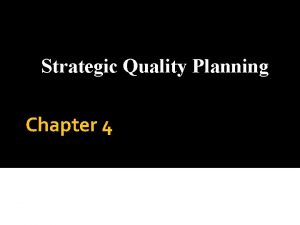APPENDIX 1 Strategic Quality System Model APPENDIX 2






- Slides: 6

APPENDIX 1: Strategic Quality System Model

APPENDIX 2: Great Care Goals and Actions PERSONAL CARE is responsive to and focused on the individual and: § Identifies and respects individual needs § Is caring, empathic and supportive § Provides care as a partnership between consumers, carers and staff § Ensures consumers are informed and understood § Is culturally appropriate § Happens in a clean and comfortable environment EFFECTIVE CARE is the right care with the best possible results, achieved by: § Correct diagnosis based on skilled assessment and the right tests § Competent, credentialed staff working within their scope of practice § The right care and treatment based on best available evidence; and senior staff knowledge and experience § Care needs expertly met § Eliminating unnecessary tests and treatment CONNECTED CARE provides a smooth, integrated pathway and: § Provides the easiest possible access to the care required § Delivers care and services when required § Is based on collaborative care planning and implementation § Strives for a smooth, coordinated journey driven by shared understanding of care pathways between staff and consumers § Avoids ‘surprises’ for consumers and carers by keeping everyone on the same page SAFE CARE keeps people free from harm such as: § § § § § Infection Falls and Pressure Injuries Medication errors Incorrectly identified or administered blood Incorrect consumer identification Wrong side or site surgery and retained instruments Unidentified deterioration Psychological harm Other harm risks associated with a person’s condition, circumstances and care

APPENDIX 3: Strategic Quality System Framework Components An effective and strategic quality system comprises: Components A clear PURPOSE that paints a rich picture of the quality of care you want to provide and be known for (Great Care) Key goals for the care to be provided to every consumer: • Personal • Effective • Connected • Safe PEOPLE with clear roles in providing Great Care Specific descriptions of the contribution everyone makes regardless of where they sit in the organisation PILLARS OF GOVERNANCE and SYSTEMS that support the people to fulfil their roles Governance and systems that actively support the people to create great care: • Leadership and Culture • Consumer Partnerships • Positive People and Practice • Pursuing High Performance

APPENDIX 4: TIPS FOR LEADING GREAT CARE 1. Start Where You Really Are – not where you’d like to be. Confront the brutal facts of the situation you find yourself in. Admit vulnerability and that you don’t have all the answers, because no-one does. Don’t sugar coat mediocrity, but don’t dwell on it either. Get the real picture, develop the plan for improvement, and move, move. 2. Then – Start Where They Are. Work with the people who need to change to achieve great care, to define what that means to them, and how it would look and feel every day. Make the case for change based on how the current situation affects everyone. Remember that information drives understanding but feeling drive action. Don’t rely on data to make the case for change. Give it a human face. 3. Develop a set of shared, non-negotiable goals for greatness. From these conversations, develop a set of clear great care goals and map out a simple plan for achieving them. Don’t over-engineer it – simplify it until everyone involved can discuss the goals and how they are to be achieved in their own way. Make achieving it part of the social fabric or the organisation, as well as part of the systems and governance. Understand that the plan may change as circumstances change, but the goals do not. Learn from wins and losses, adjust strategies as necessary, and move on. 4. Embrace the hard yards together. Be honest about what it will take to get from where you are to where you want to go and the barriers you’ll confront. People support what they help to create, so seek input and advice from everyone involved about how to get things moving in the right direction. Work together through the challenges to make it happen. Greatness is won in the tough times! Learn, take a breath and keep going. 5. Make it as easy as possible to win. Make sure everyone understands their own, specific, unique role in achieving the goals and can use their strengths and talents to progress the plan. Learn from success stories as much as from problems. Provide support, guidance and resources to make achieving the goals business as usual. Remove barriers so that it’s as easy as possible for people to do the right thing. Then hold each other to account for doing the right thing. 6. Model the behaviour you want to see in the team. Leaders – lead! Be the goals and values on two legs. Get amongst it. Guide the process, pick the team up when things don’t go to plan, and celebrate when they do. You don’t have to be sombre to be serious. Make sure your team has some serious fun as well as hard work. And get some support for yourselves - leadership is a challenge. Take your role seriously – and enjoy every minute.

APPENDIX 5: QUALITY SUCCESS MINDSET PROVIDING QUALITY CARE AND SERVICES IS EASY FOR US Mindset PROVIDING QUALITY CARE AND SERVICES IS AN ONGOING CHALLENGE Mindset We’re us – so we must be good! All services face the same challenges in providing consistently high quality care - and anyone can go backwards Everyone here knows what good care is and is out there trying hard to achieve it ‘High quality care and services’ must be clearly and simply defined so everyone has a common understanding of what we’re trying to achieve with every consumer Our consumers love us and would tell us if they were unhappy We know that our consumers may feel vulnerable when in our care and may find it hard to speak up I’m sure our staff always do the right thing and provide the best care Our staff are busy, work under pressure and have good and bad days – and work with good and bad systems – so require ongoing training and active support to provide good care We have all the quality governance systems in place we are required to have We must monitor and adjust our systems to ensure they effectively support the delivery of consistently good care We’re on top of our risks The risk situation is dynamic and changing and requires robust monitoring and management We’re accredited – so we must provide high quality care Accreditation is a snapshot in time. What are the high performing services similar to ours doing with and for their consumers to go beyond compliance? The quality manager does a great job of looking after ‘quality’ Every person in our organisation has a specific role in and responsibility for creating a quality consumer experience at point of care 5

APPENDIX 6 : TURBO CHANGE MODEL OVERVIEW 1. Clear goal: What are we trying to achieve by making the change? 7. Decision: If yes: embed and spread with governance and systems If no: revisit the goal – is it the right one? If yes, re-start course correction from step 2 6. Inter and post pilot data collection: How do things work after we’ve made the changes? Do the subjective and objective data show we achieved our goal? 5. Build and implement ‘skill’: plan and implement the changes in a pilot, using DKRS and MMAAP 2. SWTA with pre data collection: How do things work now? : Subjective and objective perspectives 3. Build ‘will’: make the case for change: stories for hearts and facts for heads. Agree the definition of success 4. Decide three big changes that must be taken to achieve the goal and the steps within each











